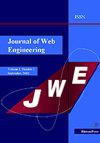Generative AI-Driven Graphic Pipeline for Web-Based Editing of 4D Volumetric Data
IF 1
4区 计算机科学
Q4 COMPUTER SCIENCE, SOFTWARE ENGINEERING
引用次数: 0
Abstract
This paper proposes a novel approach to adding and editing clothing and movement of 4D volumetric video data in a web-based environment. While significant advancements have been made in 3D modeling and animation, efficiently editing 3D mesh data produced in sequence remains a challenging problem. Since 3D mesh data synthesized from multiple cameras exists continuously over time, modifying a single 3D mesh model requires consistent editing across multiple frames. Most existing methods focus on single meshes or static 3D models, limiting their ability to handle the complexity of timevarying 3D mesh sequences. The method proposed in this paper targets 3D volumetric sequences synthesized from multiple cameras. It utilizes deep learning networks to estimate body poses, facial features, and hand shapes from RGB images, generating 3D models using the SMPL-X method. Subsequently, an algorithm is applied to segment the 3D mesh, separating and combining the head and torso of the model to create a new 3D model. In the web-based environment, this process makes the data editable, allowing for adding new motions or replacing clothing, which can be seamlessly composited into the existing sequence video. The proposed method enables editing and modification of various types of 3D mesh sequences, facilitating enhancements to existing sequences, such as changing the motion of characters or replacing their clothing, thereby improving the overall quality of 3D content creation in online applications.生成式ai驱动的基于web的四维体数据编辑图形管道
本文提出了一种在网络环境下添加和编辑4D体视频数据的服装和运动的新方法。虽然在3D建模和动画方面取得了重大进展,但有效地编辑按顺序生成的3D网格数据仍然是一个具有挑战性的问题。由于多个摄像机合成的3D网格数据随着时间的推移而持续存在,因此修改单个3D网格模型需要跨多个帧进行一致的编辑。大多数现有方法侧重于单个网格或静态3D模型,限制了它们处理时变3D网格序列复杂性的能力。本文提出的方法是针对多台摄像机合成的三维体序列。它利用深度学习网络从RGB图像中估计身体姿势、面部特征和手部形状,并使用SMPL-X方法生成3D模型。随后,应用算法对三维网格进行分割,将模型的头部和躯干分离合并,生成新的三维模型。在基于网络的环境中,这个过程使数据可编辑,允许添加新的动作或更换衣服,这可以无缝地合成到现有的序列视频中。所提出的方法能够编辑和修改各种类型的3D网格序列,促进对现有序列的增强,例如改变角色的运动或更换其服装,从而提高在线应用程序中3D内容创建的整体质量。
本文章由计算机程序翻译,如有差异,请以英文原文为准。
求助全文
约1分钟内获得全文
求助全文
来源期刊

Journal of Web Engineering
工程技术-计算机:理论方法
CiteScore
1.80
自引率
12.50%
发文量
62
审稿时长
9 months
期刊介绍:
The World Wide Web and its associated technologies have become a major implementation and delivery platform for a large variety of applications, ranging from simple institutional information Web sites to sophisticated supply-chain management systems, financial applications, e-government, distance learning, and entertainment, among others. Such applications, in addition to their intrinsic functionality, also exhibit the more complex behavior of distributed applications.
 求助内容:
求助内容: 应助结果提醒方式:
应助结果提醒方式:


